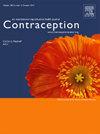产后低奶风险人群的产后立即避孕植入和母乳喂养成功:一项随机非劣效性试验
IF 2.3
2区 医学
Q1 OBSTETRICS & GYNECOLOGY
引用次数: 0
摘要
目的:我们的目的是测量产后植入时间对母乳喂养成功率和持续时间的影响,在母乳供应低的高危人群中。研究设计:我们进行了一项三臂随机非劣效性研究,研究对象是产后计划母乳喂养且已知低奶供应危险因素的人。根据植入时间,参与者被随机分为三组:胎盘分娩30分钟内,产后24-72小时内,或产后6周以上。主要观察指标为乳酸发生时间II (LII)。次要结局包括母乳喂养的持续时间和排他性以及产后6个月避孕植入物的满意度。结果:我们招募了155名参与者。与产后6周以上植入物组相比,产后≤30分钟(平均差异2.92小时,95%CI: -9.26, 15.1, p=0.64)或产后1-3天(平均差异-0.75小时,95%CI: -13.02, 11.51, p=0.90)植入物组到LII的时间差异无统计学意义。意向治疗分析也观察到类似的结果。母乳喂养的持续时间和排他性以及种植体满意度在所有组中相似。结论:不幸的是,我们的结果没有达到非劣效性的阈值,因为置信区间包括了先验定义的8小时非劣效性边际。然而,我们的结果表明,两组之间的LII时间相似。最终,我们的研究表明,早期植入依替诺孕酮不会影响产后低奶风险人群的母乳喂养成功。本文章由计算机程序翻译,如有差异,请以英文原文为准。
Immediate postpartum contraceptive implant placement and breastfeeding success in postpartum people at risk for low milk supply: A randomized non-inferiority trial
Objectives
Our goal was to measure the impact of postpartum contraceptive implant insertion timing on breastfeeding success and duration in a population at high-risk for low milk supply.
Study design
We conducted a three-armed randomized non-inferiority study of postpartum people who plan to breastfeed and have known risk factors for low milk supply. Participants were randomized to one of three groups for the timing of implant placement: within 30 minutes of placental delivery, 24–72 hours postpartum, or 6+ weeks postpartum. The primary outcome was time to lactogenesis II (LII). Secondary outcomes included duration and exclusivity of breastfeeding and implant satisfaction through 6 months postpartum.
Results
We enrolled 155 participants. Compared to those who received implants 6+ weeks postpartum, those who received it ≤30 minutes postpartum (mean difference: 2.92 hours, 95% CI: −9.26, 15.1, p = 0.64) or 1–3 days postpartum (mean difference: −0.75 hours, 95% CI: −13.02, 11.51, p = 0.90) had similar time to LII. Similar results were observed for intention to treat analysis. Duration and exclusivity of breastfeeding and implant satisfaction were similar among all groups.
Conclusions
Unfortunately, our results did not meet the threshold of non-inferiority because the confidence intervals included the 8 hours non-inferiority margin defined a priori. However, our results indicate similar time to LII between groups. Ultimately, our study suggests that early etonogestrel implant insertion does not affect breastfeeding success among postpartum people at risk for low milk supply.
Implications
Etonogestrel implant insertion can be offered anytime postpartum to meet the needs of postpartum people.
求助全文
通过发布文献求助,成功后即可免费获取论文全文。
去求助
来源期刊

Contraception
医学-妇产科学
CiteScore
4.70
自引率
17.20%
发文量
211
审稿时长
69 days
期刊介绍:
Contraception has an open access mirror journal Contraception: X, sharing the same aims and scope, editorial team, submission system and rigorous peer review.
The journal Contraception wishes to advance reproductive health through the rapid publication of the best and most interesting new scholarship regarding contraception and related fields such as abortion. The journal welcomes manuscripts from investigators working in the laboratory, clinical and social sciences, as well as public health and health professions education.
 求助内容:
求助内容: 应助结果提醒方式:
应助结果提醒方式:


